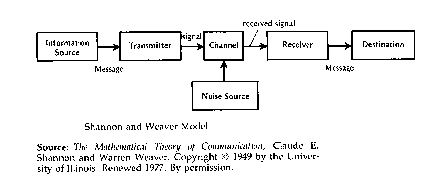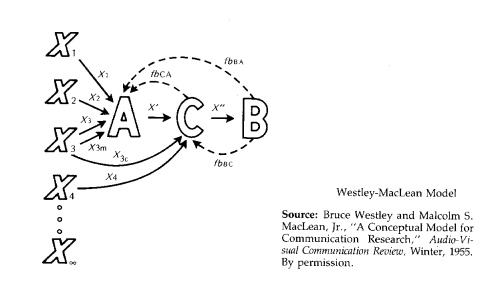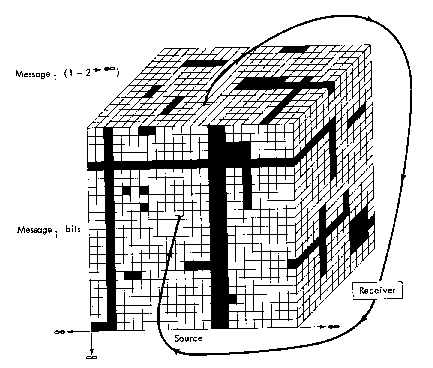
Communication Theory
Notes, John A. Cagle, Fall 2010
Dell Hymes, an anthropologist, in the late 1960s developed what he called "an ethnographic approach to communication." This work still has an influence today. Qualitative research in our field is out of this immediate tradition. Such an approach can be summarized . . . In terms of a series of four questions:
1. What are the communicative events, and their components, in a community?
2. What are the relationships among them?
3. What capabilities and states do they have, in general, and in particular events?
4. How do they work?
Basic to the series of questions is the distinction between signs and signals and sources of information generally, on the one hand, and what count as messages on the other. . . ; and the notion that the concept of message implies the full range of components present in a communicative event.
The concept of a message is taken as implying the sharing (real or imputed) of a code (or codes) in terms of which a message is intelligible to participants, minimally an addressor and addressee, in an event constituted by transmission of the message, and characterized by a channel, a setting or context, a definite form or shape in the message, and a topic or comment.
Claude Shannon developed a model at Bell Telephone Company in the 1940s. A source generated a signal from a number of alternative possibilities. The signal was then traced from a transmitter through a channel to some receiver, where the original signal was reconverted into its original form for its destination. Anything that gets in the way, distracting disturbances, was noise. His paper was informally circulated in many places and published in a Bell technical journal in 1948. It was seen to be a very significant piece of work, but highly technical and mathematical. Scientific American asked Warren Weaver to "translate" it for a general audience. Later, the University of Illinois Press published the two papers together as a book in 1949 called The Mathematical Theory of Communication. Since then their theory has been known as Shannon and Weaver's information theory.

Harold D. Lasswell in 1948 posed a simple verbal model that got wide circulation and is quoted today in books: Who Says What in Which Channel To Whom With What Effect?
In the 1950s there were many attempts to begin formulating scientific communication theories. For example in 1953 Franklin Fearing published a paper in which he tried to place communication in the content of Psychology's current personality and cognitive-perceptual theories. Here is a sample of his approach:
Communication behavior is a specific form of molar behavior which occurs in a situation or field possessing specified properties, the part of which are in interdependent relationship with each other. A theory of such behavior is concerned with forces, psychological, social, and physical, which determine the course of this behavior and its outcomes in relation to the culture in which it occurs. Such a theory should formulate hypothetical constructs and present a terminology with appropriate definitions in the following four interrelated areas:
(a) the forces which detemine the effects of communication, that is, constructs regarding individuals designated interpreters;
(b) the forces which determine the production of communications, that is, constructs about communicators;
(c) the nature of communications content considered as a stimulus field;
(d) the characteristics of the situation or field in which communication occurs.
In 1953 Theodore Newcomb presented what was to be one of the most popular of the cognitive consistency theories. He wrote that:
 The essential assumption is that communication among humans
performs the essential function of enabling two or more individuals to maintain
simultaneous orientation toward one another as communicators and toward objects of
communication. . . . The term "orientation" is used as equivalent to
"attitude" in its more inclusive sense of referring to both cathectic and
cognitive tendencies. A-B-X is regarded as a system. The essential theory posits that
imbalance in part of the system creates psychological stress or pressure to change other
parts of the system.
The essential assumption is that communication among humans
performs the essential function of enabling two or more individuals to maintain
simultaneous orientation toward one another as communicators and toward objects of
communication. . . . The term "orientation" is used as equivalent to
"attitude" in its more inclusive sense of referring to both cathectic and
cognitive tendencies. A-B-X is regarded as a system. The essential theory posits that
imbalance in part of the system creates psychological stress or pressure to change other
parts of the system.
Westley and MacLean in 1957 extended the model to describe mass communication.

Beginning in the 1950s, Noam Chomsky at MIT has been devoted to a scientific account of language or of grammar. Grammar is what a native speaker needs to know in order to understand and produce utterances. He believes grammar must account for how a speaker can produce an infinite set of novel sentences from just a few rules. The general name for his theory is generative-transformational grammar. He distinguished between competence (what the speaker needs to know) and performance (what utterances are actually produced). At the performance level, we look at only the surface structure of what people say. But the more interesting questions in grammar are the deep structures, the underlying generative and transformational rules which enable the speaker to produce those sentences.
Another linguist, Kenneth Pike, suggested that we need to be careful about distinguishing what level of observation we are making when we studying language behaviors. He posed some terms based on the study of sounds: phonetics studies individual sounds at the level of utterance, phonemics studies classes of all sounds that may be recognized as a particular sound. How many ways can people say some word (think of different dialects); the variations are all recognizable as being ways of saying a particular sound. At some point, of course, the sounds become different enough that you are in a new class. Pike urged linguists and anthropologists to be clear about whether they were looking at etic or emic behaviors.
In The Prospect of Rhetoric
(1968), Sam Becker presented a mosaic model of communication, arguing
that "our traditional concept of the message has severely limited usefulness for
understanding contemporary communication. The emphasis of rhetorical studies should
probably  remain
upon the message, in a way that is more descriptive of what man as receiver is exposed to,
rather than what man as source creates." We construct message which "are, in
effect, overlayed to form the large and complex communication environment or 'mosaic' in
which each of us exists. This mosaic consists of an immense number of fragments or bits of
information on an immense number of topics. . . . These bits are scattered over time and
space and modes of communication. Each individual must grasp from this mosaic those bits
which serve his needs, must group them into message sets which are relevant for him at any
given time, and within each message set must organize the bits and close the gaps between
them in order to arrive at a coherent picture of the world to which he can respond."
My notion of a mosaic model of communication theories is an extension of Becker's mosaic,
which itself was stimulated by Marshall McLuhan's view of the television image as a
mosaic.
remain
upon the message, in a way that is more descriptive of what man as receiver is exposed to,
rather than what man as source creates." We construct message which "are, in
effect, overlayed to form the large and complex communication environment or 'mosaic' in
which each of us exists. This mosaic consists of an immense number of fragments or bits of
information on an immense number of topics. . . . These bits are scattered over time and
space and modes of communication. Each individual must grasp from this mosaic those bits
which serve his needs, must group them into message sets which are relevant for him at any
given time, and within each message set must organize the bits and close the gaps between
them in order to arrive at a coherent picture of the world to which he can respond."
My notion of a mosaic model of communication theories is an extension of Becker's mosaic,
which itself was stimulated by Marshall McLuhan's view of the television image as a
mosaic.
Watzlawick, Beavin, and Jackson published The Pragmatics of Human Communication in 1967. It became an extremely influential book. Interesting, it has been used in freshman introduction to communication courses as well as doctoral seminars. Their theory is based on a systems paradigm. The book posited five axioms of communication:
1. One cannot not communicate.
2. Every communication has a content and a relationship aspect such that the latter defines the former and is therefore metacommunication.
3. Every communication sequence is defined by the way the interactants punctuate communication events.
4. Interpersonal contacts are digital and analogic.
5. Communication relationships are either symmetrical or complementary.
Frank E. X. Dance at the University of Denver in 1970 did a survey of definitions of communication in several fields and in our publications. His study identified 15 distinct conceptual components in the various definitions. His analysis identified three points of "critical conceptual differentiation" which form the basic dimensions along which the various definitions differ: (1) Level of observation. E.g., restricted as in a definition pertaining to radio communication, very broad as in Stevens's definition of communication as a discriminatory response of a organism to a stimulus. (2) Intentionality. (3) Normative judgment. Implicit judgment as to success or value of the behavior.
John W. Bowers and James Bradac in 1984 wrote an article which identified major competing axioms and issues in communication theory and research.